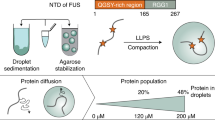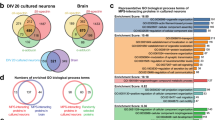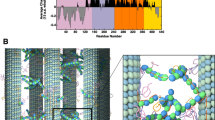Abstract
Neurofilaments (NF)—the principal cytoskeletal constituent of myelinated axons in vertebrates—consist of three molecular-weight subunit proteins NF-L (low), NF-M (medium) and NF-H (high), assembled to form mature filaments with protruding unstructured C-terminus side arms1,2,3,4,5. Liquid-crystal gel networks of side-arm-mediated neurofilament assemblies have a key role in the mechanical stability of neuronal processes. Disruptions of the neurofilament network, owing to neurofilament over-accumulation or incorrect side-arm interactions, are a hallmark of motor-neuron diseases including amyotrophic lateral sclerosis3,4,5,6,7,8,9. Using synchrotron X-ray scattering, we report on a direct measurement of forces in reconstituted neurofilament gels under osmotic pressure (P). With increasing pressure near physiological salt and average phosphorylation conditions, NF-LMH, comprising the three subunits near in vivo composition, or NF-LH gels, undergo for P>Pc≈10 kPa, an abrupt non-reversible gel-expanded to gel-condensed transition. The transition indicates side-arm-mediated attractions between neurofilaments consistent with an electrostatic model of interpenetrating chains. In contrast, NF-LM gels remain in a collapsed state for P<Pc and transition to the gel-condensed state at P>Pc. These findings, which delineate the distinct roles of NF-M and NF-H in regulating neurofilament interactions, shed light on possible mechanisms for disruptions of optimal mechanical network properties.
This is a preview of subscription content, access via your institution
Access options
Subscribe to this journal
Receive 12 print issues and online access
$259.00 per year
only $21.58 per issue
Buy this article
- Purchase on Springer Link
- Instant access to full article PDF
Prices may be subject to local taxes which are calculated during checkout




Similar content being viewed by others
References
Janmey, P. A., Leterrier, J. F. & Herrmann, H. Assembly and structure of neurofilaments. Curr. Opin. Colloid Interface Sci. 8, 40–47 (2003).
Xu, Z. S. et al. Subunit composition of neurofilaments specifies axonal diameter. J. Cell Biol. 133, 1061–1069 (1996).
Xu, Z., Cork, L. C., Griffin, J. W. & Cleveland, D. W. Increased expression of neurofilament subunit NF-L produces morphological alterations that resemble the pathology of human motor neuron disease. Cell 73, 23–33 (1993).
Fuchs, E. & Cleveland, D. W. A structural scaffolding of intermediate filaments in health and disease. Science 279, 514–519 (1998).
Miller, C. C. J. et al. Axonal transport of neurofilaments in normal and disease states. Cell. Mol. Life Sci. 59, 323–330 (2002).
Liu, Q. et al. Neurofilament proteins in neurodegenerative diseases. Cell. Mol. Life Sci. 61, 3057–3075 (2004).
Brady, S. Mice overexpressing the human neurofilament heavy gene as a model of ALS. Neurobiol. Aging 16, 490–492 (1995).
Hirano, A., Donnenfeld, H., Sasaki, S. & Nakano, I. Fine-structural observations of neurofilamentous changes in amyotrophic lateral sclerosis. J. Neuropathol. Exp. Neurol. 43, 461–470 (1984).
Nguyen, M. D. et al. A NUDEL-dependent mechanism of neurofilament assembly regulates the integrity of CNS neurons. Nature Cell Biol. 6, 595–608 (2004).
Hirokawa, N. in The Neuronal Cytoskeleton (ed. Burgoyne, R. D.) 5–74 (Wiley–Liss, 1991).
Hirokawa, N. Organelle transport along microtubules—the role of KIFs. Trends Cell Biol. 6, 135–141 (1996).
Brownlees, J. et al. Charcot–Marie–Tooth disease neurofilament mutations disrupt neurofilament assembly and axonal transport. Human Mol. Genet. 11, 2837–2844 (2002).
Hirokawa, N., Glicksman, M. & Willard, M. Organization of mammalian neurofilament polypeptides within the neuronal cytoskeleton. J. Cell Biol. 98, 1523–1536 (1984).
Brown, H. G. & Hoh, J. H. Entropic exclusion by neurofilament sidearms: A mechanism for maintaining interfilament spacing. Biochemistry 36, 15035–15040 (1997).
Leterrier, J. F., Kas, J., Hartwig, J., Vegners, R. & Janmey, P. A. Mechanical effects of neurofilament cross-bridges. Modulation by phosphorylation, lipids, and interactions with F-actin. J. Biol. Chem. 271, 15687–15694 (1996).
Wagner, O. I. et al. Softness, strength and self-repair in intermediate filament networks. Exp. Cell Res. 313, 2228–2235 (2007).
Gou, J. P., Gotow, T., Janmey, P. A. & Leterrier, J. F. Regulation of neurofilament interactions in vitro by natural and synthetic polypeptides sharing Lys–Ser–Pro sequences with the heavy neurofilament subunit NF-H: Neurofilament crossbridging by antiparallel sidearm overlapping. Med. Biol. Eng. Comput. 36, 371–387 (1998).
Storm, C., Pastore, J. J., MacKintosh, F. C., Lubensky, T. C. & Janmey, P. A. Nonlinear elasticity in biological gels. Nature 435, 191–194 (2005).
Rammensee, S., Janmey, P. & Bausch, A. Mechanical and structural properties of in vitro neurofilament hydrogels. Eur. Biophys. J. 36, 661–668 (2007).
Jones, J. B. & Safinya, C. R. Interplay between liquid crystalline and isotropic gels in self-assembled neurofilament networks. Biophys. J. 95, 823–835 (2008).
Geisler, N. & Weber, K. Self-assembly in vitro of the 68,000 molecular weight component of the mammalian neurofilament triplet proteins into intermediate-sized filaments. J. Mol. Biol. 151, 565–571 (1981).
Heins, S. & Aebi, U. Making heads and tails of intermediate filament assembly, dynamics and networks. Curr. Opin. Cell Biol. 6, 25–33 (1994).
Kumar, S., Yin, X. H., Trapp, B. D., Hoh, J. H. & Paulaitis, M. E. Relating interactions between neurofilaments to the structure of axonal neurofilament distributions through polymer brush models. Biophys. J. 82, 2360–2372 (2002).
Hesse, H. C. et al. Direct imaging of aligned neurofilament networks assembled using in situ dialysis in microchannels. Langmuir 24, 8397–8401 (2008).
Parsegian, V. A., Rand, R. P., Fuller, N. L. & Rau, D. C. Osmotic-stress for the direct measurement of intermolecular forces. Methods Enzymol. 127, 400–416 (1986).
Rau, D. C. & Parsegian, V. A. Direct measurement of the intermolecular forces between counterion-condensed DNA double helices—evidence for long-range attractive hydration forces. Biophys. J. 61, 246–259 (1992).
Needleman, D. J. et al. Synchrotron X-ray diffraction study of microtubules buckling and bundling under osmotic stress: A probe of interprotofilament interactions. Phys. Rev. Lett. 93, 198101–198104 (2004).
Zhulina, E. B. & Leermakers, F. A. M. A self-consistent field analysis of the neurofilament brush with amino-acid resolution. Biophys. J. 93, 1421–1430 (2007).
Pallas, N. R. & Pethica, B. A. Liquid-expanded to liquid-condensed transitions in lipid monolayers at the air water interface. Langmuir 1, 509–513 (1985).
Kyte, J. & Doolittle, R. F. A simple method for displaying the hydropathic character of a protein. J. Mol. Biol. 157, 105–132 (1982).
Acknowledgements
We thank R. Bruinsma, M. Kardar, Y. Li, A. Parsegian, P. Pincus, R. Podgornik, M. Wyrsta and E. Zhulina for discussion and correspondence and M. C. Choi for help with the AFM studies. The X-ray research was carried out at the Stanford Synchrotron Radiation Lightsource and at the Lawrence Berkeley National Laboratory Light Source. AFM experiments were conducted in the Microscopy & Microanalysis Facility of the UCSB Materials Research Laboratory (supported by NSF-MRSEC). C.R.S., J.D. and J.B.J. were supported by DOE BES DE-FG-02-06ER46314 (protein purification and assembly, characterization) and NSF DMR-0803103 (phase behaviour). R.B. was supported by the Human Frontier Science Program organization and in part by DOE BES.
Author information
Authors and Affiliations
Contributions
This letter was written by R.B., C.R.S. and J.D.; R.B. collected and analysed the X-ray, AFM and microscopy data and assisted in purifying the protein; J.D. purified the proteins and collected the X-ray and microscopy data. J.B.J. carried out preliminary measurements and refined the protein purification protocol. C.R.S. designed the original study; R.B., J.D. and J.B.J. were involved in the study design. The data were interpreted by R.B., J.D. and C.R.S.; J.B.J. commented on the final manuscript.
Corresponding authors
Supplementary information
Supplementary Information
Supplementary Information (PDF 631 kb)
Rights and permissions
About this article
Cite this article
Beck, R., Deek, J., Jones, J. et al. Gel-expanded to gel-condensed transition in neurofilament networks revealed by direct force measurements. Nature Mater 9, 40–46 (2010). https://doi.org/10.1038/nmat2566
Received:
Accepted:
Published:
Issue Date:
DOI: https://doi.org/10.1038/nmat2566
This article is cited by
-
Skin hydration: interplay between molecular dynamics, structure and water uptake in the stratum corneum
Scientific Reports (2017)
-
Tau mediates microtubule bundle architectures mimicking fascicles of microtubules found in the axon initial segment
Nature Communications (2016)
-
Neurofilament dynamics and involvement in neurological disorders
Cell and Tissue Research (2015)
-
Continuity of states between the cholesteric → line hexatic transition and the condensation transition in DNA solutions
Scientific Reports (2014)
-
Stimuli-sensitive intrinsically disordered protein brushes
Nature Communications (2014)



